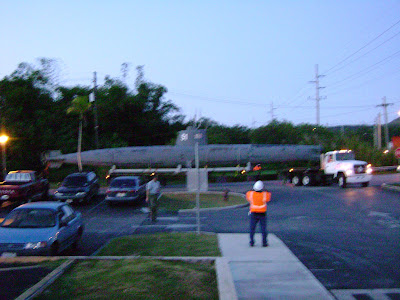My third day on the island is also my first day at my new job. In retrospect it was extremely short sided to begin my job so soon after my arrival. I wish I had allowed myself an entire week or at least another day or two to search for a place to live, or a car or even to explore. But instead on Monday morning, March 31st, I check out of my hotel, pack my bags in my rental car and head to work. Do I know where I will be sleeping later that night? Nope. All I know is I can no longer afford to stay at that hotel. I arrive at the Park Headquarters in Hagatna, Guam's capitol. I do the standard meet and greet followed by hours of paper work then I drive the government vehicle to the Visitor Center about 8 miles south of Hagatna near Santa Rita. Although the VC has been open since July, almost all the exhibits are temporary. A short time later I head to lunch with my new coworkers James and Robert. We meet one of James' friends Bret. Coincidentally, Bret is looking to rent out a room at his house in Tumuning. It is affordable and on a month to month basis. I jump all over that.
After my second day at work, a day spent doing paper work and reading a large volume of "Standard Operating Procedures for Interp Division," NPS people begin to arrive at the VC. I am then told we are about to receive an original 80 foot Japanese Midget Submarine from the Navy base. KICK ASS! Its new home will be right in front of the Visitor Center.
After another two hours of waiting it arrives. Guided by a police escort, the sub sails into view sitting on top of a flatbed trailer. The trailer is only 60 feet long, so about 20 feet of submarine is hanging off the back. It is much bigger than I imagined.

James explains the sub's history: In August 1944, this submarine beached off the southeast coast of Guam. Guam was only declared secure on August 10, a few days before. Marines swam out to the sub but the crew refused to open the hatch or come out. For days the Japanese crew refused to surrender, but finally three days later, the two man crew gave up. The sub was moved onto the island and then as the Navy base was established, began its new life as a large lawn ornament. Earlier this year the Navy decided to donate it to the National Park Service.


During the war, Japan built thousands of midget submarines. The last model, the type C could go 300 miles and reach speeds up to 20 knots. Despite the vast numbers and technical prowess, midget submarines were completely ineffective and only sunk one ship during the entire war. Only six are known to exist. We have one of them.

The sub's arrival is an excellent opportunity to get to know my new coworkers. We talk and crack jokes as we watch and wait. One of my coworkers looks confused. I ask if there is anything wrong. "I was just thinking," he begins, "is it still OK to call it a 'Midget' submarine? Maybe its not P.C. to call it that." I stare at him cautiously not knowing if he is serious. "Maybe we should call the little people sub, or the miniature sub, or something." At this point I can not help but laugh out loud. Lucky for me, people around me also heard the comment and join in my chuckle. After the sub is moved into position in what can only be described as a well choreographed ballet, we head home. In the twilight with the newly placed lighting, the 50 ton submarine dramatically beacons more than any sign possibly could.

No comments:
Post a Comment